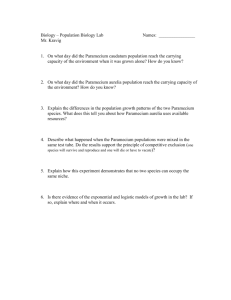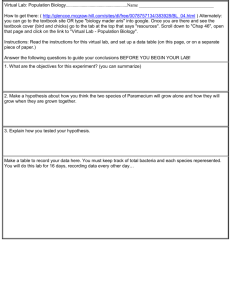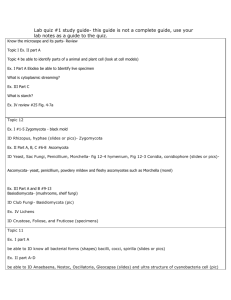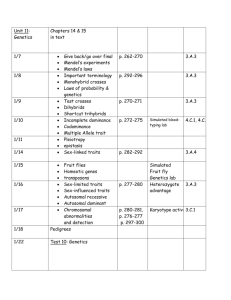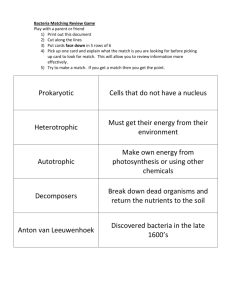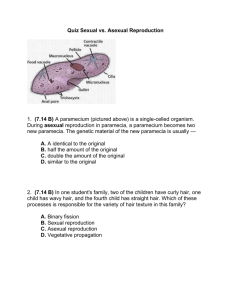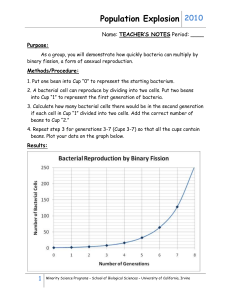First Terminal Examination 2071 Attempt all the question. First
advertisement
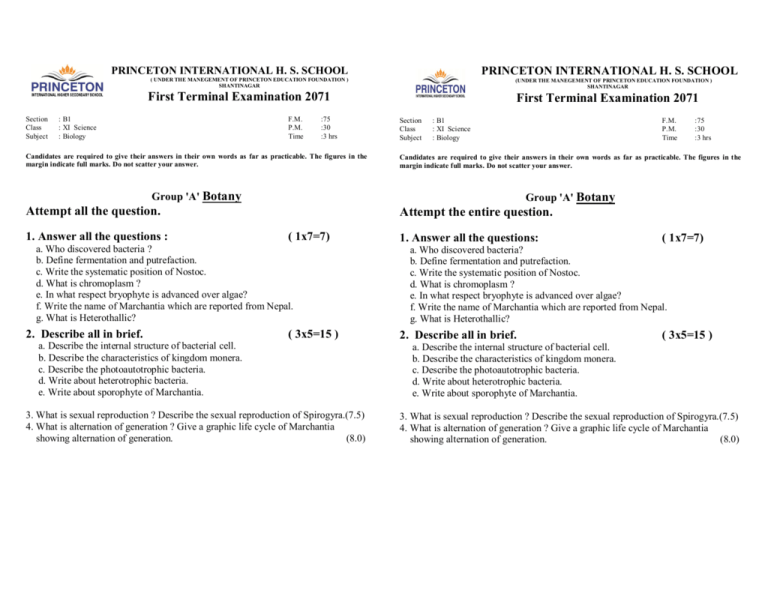
PRINCETON INTERNATIONAL H. S. SCHOOL PRINCETON INTERNATIONAL H. S. SCHOOL ( UNDER THE MANEGEMENT OF PRINCETON EDUCATION FOUNDATION ) SHANTINAGAR (UNDER THE MANEGEMENT OF PRINCETON EDUCATION FOUNDATION ) SHANTINAGAR First Terminal Examination 2071 Section Class Subject : B1 : XI Science : Biology F.M. P.M. Time :75 :30 :3 hrs First Terminal Examination 2071 Section Class Subject : B1 : XI Science : Biology F.M. P.M. Time :75 :30 :3 hrs Candidates are required to give their answers in their own words as far as practicable. The figures in the margin indicate full marks. Do not scatter your answer. Candidates are required to give their answers in their own words as far as practicable. The figures in the margin indicate full marks. Do not scatter your answer. Group 'A' Botany Group 'A' Botany Attempt all the question. 1. Answer all the questions : Attempt the entire question. ( 1x7=7) a. Who discovered bacteria ? b. Define fermentation and putrefaction. c. Write the systematic position of Nostoc. d. What is chromoplasm ? e. In what respect bryophyte is advanced over algae? f. Write the name of Marchantia which are reported from Nepal. g. What is Heterothallic? 2. Describe all in brief. ( 3x5=15 ) a. Describe the internal structure of bacterial cell. b. Describe the characteristics of kingdom monera. c. Describe the photoautotrophic bacteria. d. Write about heterotrophic bacteria. e. Write about sporophyte of Marchantia. 3. What is sexual reproduction ? Describe the sexual reproduction of Spirogyra.(7.5) 4. What is alternation of generation ? Give a graphic life cycle of Marchantia showing alternation of generation. (8.0) 1. Answer all the questions: ( 1x7=7) a. Who discovered bacteria? b. Define fermentation and putrefaction. c. Write the systematic position of Nostoc. d. What is chromoplasm ? e. In what respect bryophyte is advanced over algae? f. Write the name of Marchantia which are reported from Nepal. g. What is Heterothallic? 2. Describe all in brief. ( 3x5=15 ) a. Describe the internal structure of bacterial cell. b. Describe the characteristics of kingdom monera. c. Describe the photoautotrophic bacteria. d. Write about heterotrophic bacteria. e. Write about sporophyte of Marchantia. 3. What is sexual reproduction ? Describe the sexual reproduction of Spirogyra.(7.5) 4. What is alternation of generation ? Give a graphic life cycle of Marchantia showing alternation of generation. (8.0) Group 'B' Zoology 5. 6. 7. 8. Answer in very short. ( 1x7=7) a) What are coacervates? b) Why is encystation? c) Define cyclosis. d) What is ex- conjugation? e) Give the significances of conjugation. f) When was the life originated? g) What was the concept of biogenesis on the origin of life? Answer in short: ( 3x5=15 ) a) Give the diagrammatic representation of Miller and Urey's experiment (no description required) b) Mention the characteristic features of Protozoa. c) Give the structure and functions of contractile vacuoles in Paramecium. d) Explain cognogeny on the origin of life. e) Archaeopteryx is connecting link animal. Justify . Describe the sexual reproduction in Paramecium with necessary diagrams. (7.5) Estate the erythrocytic cycle of Malarial parasite with necessary diagram .(8) Group 'B' Zoology 5. Answer in very short. ( 1x7=7) a) What are coacervates? b) Why is encystation? c) Define cyclosis. d) What is ex-conjugation? e) Give the significances of conjugation. f) When was the life originated? g) What was the concept of biogenesis on the origin of life? 6. Answer in short: ( 3x5=15 ) a) Give the diagrammatic representation of Miller and Urey's experiment (no description required) b) Mention the characteristic features of Protozoa. c) Give the structure and functions of contractile vacuoles in Paramecium. d) Explain cognogeny on the origin of life. e) Archaeopteryx is connecting link animal. Justify . 7. Describe the sexual reproduction in Paramecium with necessary diagrams. (7.5) 8. Estate the erythrocytic cycle of Malarial parasite with necessary diagram .(8) PRINCETON INTERNATIONAL H. S. SCHOOL PRINCETON INTERNATIONAL H. S. SCHOOL ( UNDER THE MANEGEMENT OF PRINCETON EDUCATION FOUNDATION ) SHANTINAGAR ( UNDER THE MANEGEMENT OF PRINCETON EDUCATION FOUNDATION ) SHANTINAGAR First Terminal Examination 2071 Section Class Subject : B2 : XI Science : Biology F.M. P.M. Time :75 :30 :3 hrs First Terminal Examination 2071 Section Class Subject : B2 : XI Science : Biology F.M. P.M. Time :75 :30 :3 hrs Candidates are required to give their answers in their own words as far as practicable. The figures in the margin indicate full marks. Do not scatter your answer. Candidates are required to give their answers in their own words as far as practicable. The figures in the margin indicate full marks. Do not scatter your answer. Group 'A' Botany Group 'A' Botany Attempt all the question. Attempt all the question. 1. Answer all the questions : a. Write the systematic position of Spirogyra. b. Who gave the term bacterium ? c. What do you mean by symbiotic bacteria ? d. What is trichome ? e. Define cephalotrichous. f. Write the name of rhizoids found in Marchantia. g. What is homothallic ? ( 1x7=7) 2. Describe all in brief. a. Decribe the characteristics of blue green algae.. b. Describe the characteristics of bacteria. c. Describe the internal structure of Spirogyra cell. d. Write short notes on archaebacteria . e. Describe the chemoautotrophic bacteria. ( 3x5=15 ) 3. What is alternation of generation? Discuss it in the life cycle of Marchantia.(8) 4. Describe the vegetative and asexual reproduction of Nostoc and Spirogyra. (7.5) 1. Answer all the questions : a. Write the systematic position of Spirogyra. b. Who gave the term bacterium ? c. What do you mean by symbiotic bacteria ? d. What is trichome ? e. Define cephalotrichous. f. Write the name of rhizoids found in Marchantia. g. What is homothallic ? ( 1x7=7) 2. Describe all in brief. a. Decribe the characteristics of blue green algae.. b. Describe the characteristics of bacteria. c. Describe the internal structure of Spirogyra cell. d. Write short notes on archaebacteria . e. Describe the chemoautotrophic bacteria. ( 3x5=15 ) 3. What is alternation of generation? Discuss it in the life cycle of Marchantia.(8) 4. Describe the vegetative and asexual reproduction of Nostoc and Spirogyra.(7.5) Group 'B' Zoology 5. 6. 7. 8. Answer in very short. (1x7=7) a) What are the end products of Miller and Urey's experiment? b) Define Cyclosis. c) When was life evolved? d) What was the concept of theory of special creation on the origin of life? e) Give the scientific names of slipper animalcule. f) Give two main significances of conjugation in Paramecium. g) Name the locomotary organs of Paramecium. Answer in short. (3x5=15) a) Give an account of asexual reproduction in Paramecium. b) Explain the experiment conducted by Francesco Redi on the origin of life. c) Give the characteristics of Phylum protozoa. d) Explain the phylogeny of horse? e) Ontogeny recapitulate phylogeny.Justify. 5. Describe the structure of Paramecium with a well labelled diagram. (8) Describe Oparin and Haldane's theory of origin of life. (7.5) 7. 8. 6. Group 'B' Zoology Answer in very short. (1x7=7) a) What are the end products of Miller and Urey's experiment? b) Define Cyclosis. c) When was life evolved? d) What was the concept of theory of special creation on the origin of life? e) Give the scientific names of slipper animalcule. f) Give two main significances of conjugation in Paramecium. g) Name the locomotary organs of Paramecium. Answer in short. (3x5=15) a) Give an account of asexual reproduction in Paramecium. b) Explain the experiment conducted by Francesco Redi on the origin of life. c) Give the characteristics of Phylum protozoa. d) Explain the phylogeny of horse? e) Ontogeny recapitulate phylogeny.Justify. Describe the structure of Paramecium with a well labelled diagram. (8) 7 Describe Oparin and Haldane's theory of origin of life. (7.5) PRINCETON INTERNATIONAL H. S. SCHOOL PRINCETON INTERNATIONAL H. S. SCHOOL ( UNDER THE MANEGEMENT OF PRINCETON EDUCATION FOUNDATION ) SHANTINAGAR ( UNDER THE MANEGEMENT OF PRINCETON EDUCATION FOUNDATION ) SHANTINAGAR First Terminal Examination 2071 First Terminal Examination 2071 Section Class Subject : B4 : XI Science : Biology F.M. P.M. Time :75 :30 :3 hrs Candidates are required to give their answers in their own words as far as practicable. The figures in the margin indicate full marks. Do not scatter your answer. Group 'A' Botany Attempt all the question. 1. Answer all the questions : ( 1x7=7) a. What are the main components of cell membrane ? b. Define facultative bacteria. c. Write the systematic position of Marchantia. d. Why are bryophytes are called as amphibian of the plant kingdom ? e. Define antibiotic. f. Write the name of Scales found in Marchantia. g. Define primordial utricle. 2. Describe all in brief. ( 3x5=15 ) a. Write the characteristics of phaeophyceae class of algae . b. Describe the internal structure of Marchantia thallus . c. Describe the types of bacteria on the basis of shape. d. What are the differences between gram positive and gram negative bacteria ? e. Describe the beneficial importaces of bacteria. 3. Write the systematic position, internal structure and reproduction of Nostoc .(8) 4. What is sexual reproduction ? describe the life cycle of Spirogyra.(7.5) Section Class Subject : B4 : XI Science : Biology F.M. P.M. Time :75 :30 :3 hrs Candidates are required to give their answers in their own words as far as practicable. The figures in the margin indicate full marks. Do not scatter your answer. Group 'A' Botany Attempt all the question. 1. Answer all the questions : ( 1x7=7) a. What are the main components of cell membrane ? b. Define facultative bacteria. c. Write the systematic position of Marchantia. d. Why are bryophytes are called as amphibian of the plant kingdom ? e. Define antibiotic. f. Write the name of Scales found in Marchantia. g. Define primordial utricle. 2. Describe all in brief. ( 3x5=15 ) a. Write the characteristics of phaeophyceae class of algae . b. Describe the internal structure of Marchantia thallus . c. Describe the types of bacteria on the basis of shape. d. What are the differences between gram positive and gram negative bacteria ? e. Describe the beneficial importaces of bacteria. 3. Write the systematic position, internal structure and reproduction of Nostoc .(8) 4. What is sexual reproduction ? describe the life cycle of Spirogyra.(7.5) Group ‘B’ Zoology 5. 6. Answer in very short. (1x7=7) a) Give the systematic position of Paramecium. b) What do you mean by conjugation? c) Mention two important characteristics of phylum protozoa. d) What is the function of contractile vacuole? e) What are the energy sources in Miller and Urey's experiment? f) What is meant by eobionts? g) Name any two vestigial organs. Answer in short (3x5=15) Group ‘B’ Zoology 5. 6. Answer in very short. (1x7=7) a) Give the systematic position of Paramecium. b) What do you mean by conjugation? c) Mention two important characteristics of phylum protozoa. d) What is the function of contractile vacuole? e) What are the energy sources in Miller and Urey's experiment? f) What is meant by eobionts? g) Name any two vestigial organs. Answer in short (3x5=15) a) Sketch a well labelled diagram liver schizogony of Plasmodium. a) Sketch a well labelled diagram liver schizogony of Plasmodium. b) c) d) e) Explain the transverse binary fission of Paramecium. Write a note on Cognogeny. Mention the phylogenic characteristics of Horse. How morphological and anatomical evidence support the organic evolution b) c) d) e) Explain the transverse binary fission of Paramecium. Write a note on Cognogeny. Mention the phylogenic characteristics of horse. How morphological and anatomical evidence support the organic evolution 7. Describe the life cycle of Plasmodium vivax in human with well labelled diagram. (7.5) 8. Describe the sexual life cycle of Paramecium caudatum (8) 7. 8. Describe the life cycle of Plasmodium vivax in human with well labelled diagram. (7.5) Describe the sexual life cycle of Paramecium caudatum (8)
